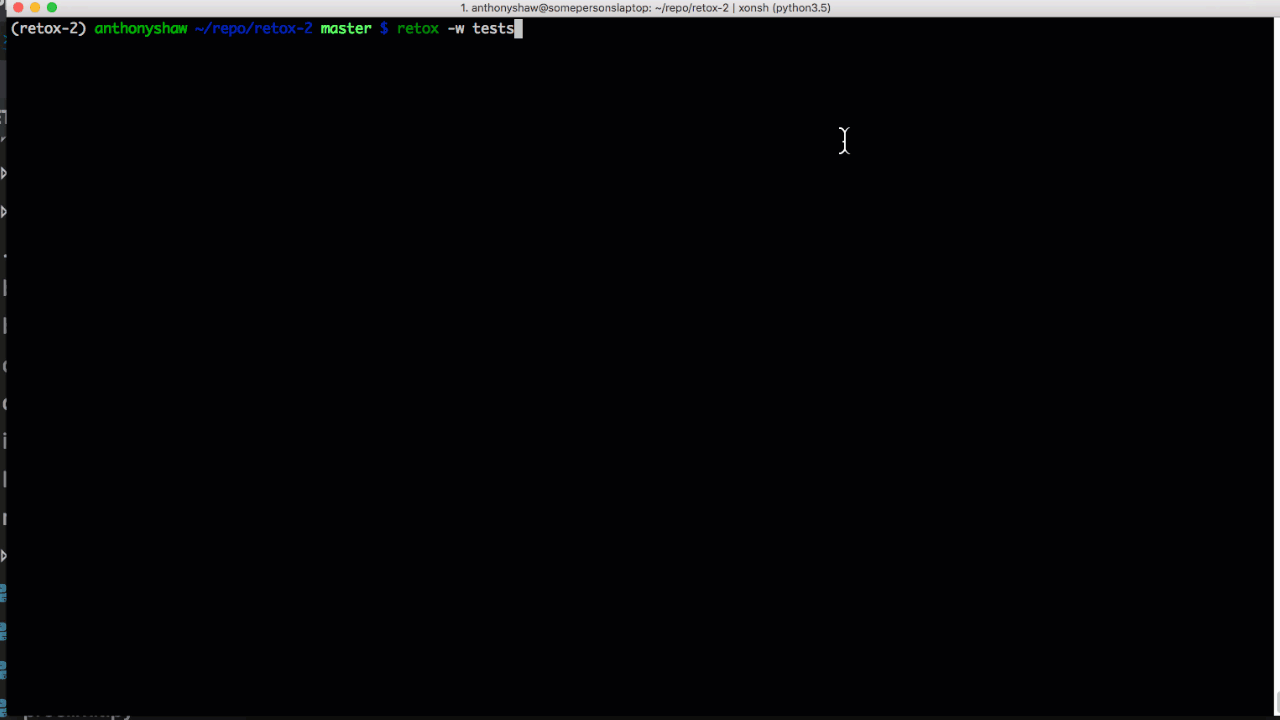A parallel service for tox
Project description





A command line service that runs your tox tests in parallel, using threading and multicore CPUs.
See your tox environments in a dashboard and automatically watch source folders for file changes and re-run tests.
See : https://github.com/tonybaloney/retox/raw/master/docs/_static/screenshot.jpeg for an example screenshot

Requirements
Linux users may need to install libncurses5-dev before using Tox. If you see an error “ImportError: No module named ‘_curses’” this is because of the Requirement.
Usage
To install, run
pip install retoxThen from any project that has a tox.ini file setup and using tox, you can simply run
retoxThis will start the service, from where you can press (b) to rebuild on demand.
Watching folders
Retox can watch one or many directories for file changes and re-run the tox environments when changes are detected
retox -w my_project_folder -w my_test_folderExcluding paths
Retox will ignore files matching a given regex:
retox -w my_project_folder --exclude='.*\.(swp|pyc)$'Tox support
Any tox arguments can be given to the command, and using –help to get a full list of commands. Tox arguments will be passed to all virtualenvs
retox -e py27,py36multicore configuration
The number of concurrent processes in the threadpool can be set using the -n parameter. By default this will be equal to the number of CPU’s on the OS. If you want to expand or throttle this, use the flag to change the size of the threadpool.
retox -n 4Logging
2 files will be created - .retox.log, which is a file for all runs of the logs for the virtual environments. This can be handy to tail to see live output .retox.json - a JSON file with the virtualenv tasks and specific command output.
Credits
This was inspired by the detox project, which was created by the tox development team. I worked and then significantly changed the way it works to support re-running environments with ease.
Project details
Release history Release notifications | RSS feed
Download files
Download the file for your platform. If you're not sure which to choose, learn more about installing packages.
Source Distribution
Built Distribution
File details
Details for the file retox-1.5.0.tar.gz.
File metadata
- Download URL: retox-1.5.0.tar.gz
- Upload date:
- Size: 525.5 kB
- Tags: Source
- Uploaded using Trusted Publishing? No
File hashes
| Algorithm | Hash digest | |
|---|---|---|
| SHA256 | f5efe91399d31ea91d6e251ed6da21702d38ea35d75576691993975b14acbcb5 |
|
| MD5 | 46814075a188e2e665d93b8f0147067f |
|
| BLAKE2b-256 | bfc520e8acd7fc527b98c409278cb8c72c966119f3870769f225a4fd105d73d0 |
File details
Details for the file retox-1.5.0-py3-none-any.whl.
File metadata
- Download URL: retox-1.5.0-py3-none-any.whl
- Upload date:
- Size: 13.4 kB
- Tags: Python 3
- Uploaded using Trusted Publishing? No
File hashes
| Algorithm | Hash digest | |
|---|---|---|
| SHA256 | 75be7719f3753d635391c803fea808a8a42149dd457c0d480fccd8d15c7d28da |
|
| MD5 | 93e94a9d686479cc489fd1a88f0a9534 |
|
| BLAKE2b-256 | 0bbdfc0ab02848a0b3c00ac871e0be5f4ba1645b6748989be945b483b0fabd11 |











